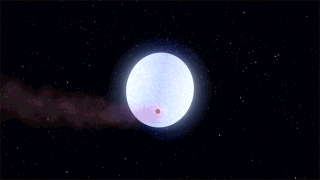
The hottest exoplanet ever found is so infernally hot that it’s ripping apart hydrogen molecules in its atmosphere, astronomers have found.
“Hot Jupiters” are massive gas giants that orbit so close to their stars that they are too hot to sustain life. One such planet, KELT-9b, is an ultrahot Jupiter that resides 670 light-years from Earth. It weighs about three times the mass of Jupiter and boasts surface temperatures of 7,800 degrees Fahrenheit (4,300 degrees Celsius). This makes KELT-9b the hottest exoplanet so far discovered. It’s even hotter than some stars.
Using NASA’s Spitzer Space Telescope, a team of astronomers has found that, most likely, the planet is so hot that molecules in the planet’s atmosphere can’t stay together. The team found evidence that molecules of hydrogen gas are torn apart on the planet’s dayside.
Related: Gallery: The Strangest Alien Planets
More: Extremely Hot and Incredibly Close: How Hot Jupiters Defy Theory
Now, while the planet’s nightside is still extremely hot, it is cool enough that once the disconnected atoms from the torn-apart hydrogen molecules find their way to the planet’s nightside, they are able to re-form. But the atomic reunion doesn’t last long, as the molecules are once again ripped apart when they flow back to the planet’s dayside.
In a new paper explaining these findings, the researchers also provide evidence that KELT-9b is not the only planet where molecules being ripped apart; it likely happens on other ultrahot exoplanets as well.
“This kind of planet is so extreme in temperature, it is a bit separate from a lot of other exoplanets,” Megan Mansfield, a graduate student at the University of Chicago and lead author of this new paper, said in a NASA statement. “There are some other hot Jupiters and ultra-hot Jupiters that are not quite as hot but still warm enough that this effect should be taking place.”
To find this evidence, the team used data from the Spitzer Space Telescope (set to “die” this Thursday, Jan. 30), which makes observations in infrared light and can show subtle variations in heat. By analyzing Spitzer data on KELT-9b’s temperature, the researchers were able to see changes in the planet’s atmosphere on both its day- and nightsides as it orbited its star.
The planet orbits its star so closely that each “year” lasts only 1.5 Earth days. KELT-9b is also tidally locked, meaning each side (day and night) face either permanently toward or away from its star. But despite being tidally locked, gases and heat flow from the dayside to the nightside. In studying the planet, researchers found that the best explanation for the atmospheric and temperature data was a model that included hydrogen molecules being torn apart and reassembled as they flow around the planet.
Scientists studied the hostile, uninhabitable environment on KELT-9b in 2017 with the Kilodegree Extremely Little Telescope (KELT) system, a collaborative system that uses observations from telescopes in southern Arizona and South Africa.
This work was published Jan. 7 in the The Astrophysical Journal Letters.
Follow Chelsea Gohd on Twitter @chelsea_gohd. Follow us on Twitter @Spacedotcom and on Facebook.







